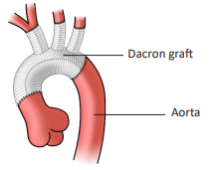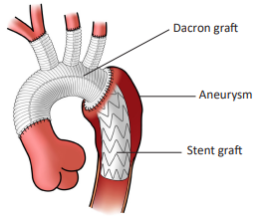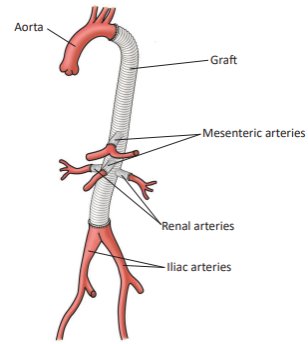Open Surgical Options for Aortic Dissection
TALK TO AN AORTIC NURSE
The Northwestern Medicine Center for Aortic Care at Bluhm Cardiovascular Institute performs open surgery to treat certain aortic dissections. An aortic dissection is a tear in your aorta.
Surgery may be needed to repair your aortic dissection. Your care team will determine which surgery is best for your needs.
Surgical repair for aortic dissection depends on the location and extent of the tear in the aorta. If the tear is near the heart, typically emergency surgery is required.
Aortic Root Replacement Surgery
The aortic root is the first part of the aorta. An aortic root aneurysm is a bulging or weak spot that occurs at the beginning of the aorta. You may need surgery to replace the diseased aortic root. This surgery can help prevent more damage to the aortic root, aortic heart valve or the aorta.
During aortic root replacement surgery, the surgeon removes the diseased aortic root. Then, they replace it with a tube (graft) made of synthetic material that allows blood to flow through it. The aortic valve may need to be repaired or replaced depending on the extent of disease to the valve.
There are different procedures to replace the aortic root.
Aortic Root Replacement With Valve Replacement (Bentall Procedure)
This surgery replaces the diseased aortic root and the diseased aortic valve. The surgeon replaces the diseased aortic root with a graft. They replace the aortic valve with a mechanical valve or a tissue (bioprosthetic valve).
Mechanical valves are made of special carbon compounds and titanium. The valves are designed to last for the rest of your life. Because the valve is metal, you will need to take blood-thinning medications (called anticoagulants) for the rest of your life. Anticoagulation is necessary to prevent blood from clotting on the metal causing blood clots.
Bioprosthetic valves are made from animal valves, usually pigs or cows. They do not last as long as mechanical valves because they are made from natural tissue. If you have a bioprosthetic valve, you do not have to take anticoagulants.
Valve-Sparing Aortic Root Replacement (David Procedure)
This surgery replaces the diseased aortic root with a graft and leaves your healthy aortic valve in place. Because the aortic valve is not replaced, you do not need to take blood-thinning medications.
There are different procedures to replace the aortic arch. Your aortic arch is the curved part of your aorta. There are three main arteries that come off the aortic arch that provides blood flow to your head, upper body and arms.
Hemi Arch Repair Surgery
During this surgery, the surgeon removes part of your aortic arch. They replace it with a tube made of synthetic material (called a graft) that lets blood flow through it. Native aortic arch tissue (your own tissue) that surrounds the three main arteries is left in place. This restores blood flow to your head, upper body and arms.
Total Aortic Arch Replacement Surgery
In this surgery, the entire aortic arch is removed. It is replaced with a graft. In this surgery, the tissue around the three main arteries is also replaced. The surgeon replaces parts of these arteries with grafts. This restores blood flow to your head, upper body and arms.
If you have a complex aneurysm or dissection in your aortic arch, your surgical team may perform an "elephant trunk" graft extension.


Open Thoracoabdominal Aortic Repair Surgery
A thoracoabdominal aortic aneurysm or dissection happens when an aneurysm or dissection goes from the chest (descending thoracic aorta) into the abdomen.
Surgery to repair a thoracoabdominal aortic aneurysm or dissection is called an open thoracoabdominal aortic repair. The surgeon removes the diseased aorta and replaces it with a graft.
The aorta has many arteries that provide blood to the intestines, kidneys and pelvic area. The surgeon detaches these arteries from the aorta during this surgery. They replace part of the arteries with grafts that have small openings. They were customized to fit the patient’s aortic needs. This restores blood flow.

Meet the Aortic Dissection Team
| Northwestern Medicine Bluhm Cardiovascular Institute is a nationally recognized destination for those who require highly specialized cardiovascular care. | Meet the Teams Downtown Chicago |
